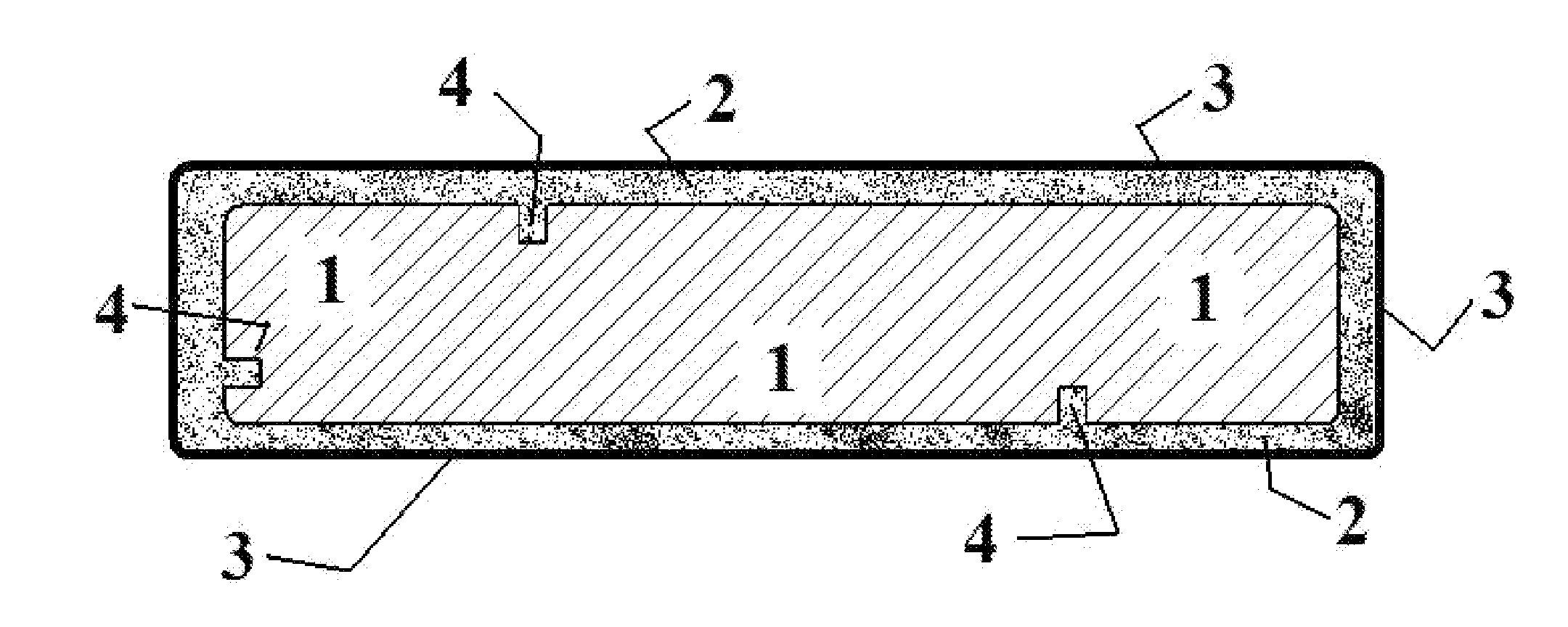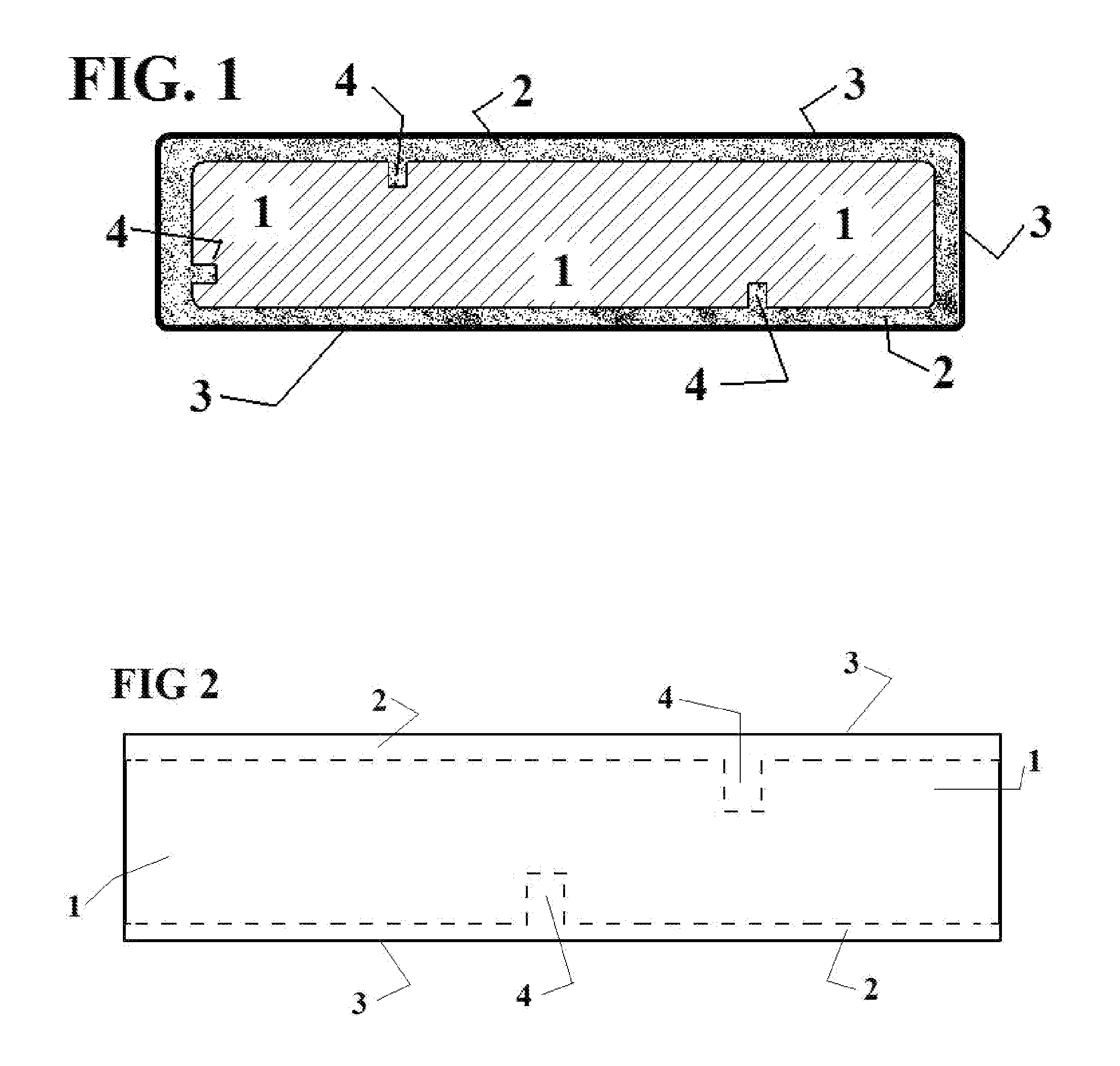. . extruded
plastic lumber is not as strong as wood, and is more fragile and difficult to work with than wood.
The current, EPA accepted wood treatment technologies have failed to provide rot-protection even close to the now-unacceptable CCA treatments.
This failure of the present EPA acceptable wood lumber treatments presents the industry with a short-time-
horizon as older, in-situ, CCA-treated lumber and the new treated lumber reach end-of-service-life-cycles together.
To date, there are no commercially available substitute products for traditional, treated, dimensional lumber, which provide strength and stiffness characteristics similar to high strength, CCA-treated SYP.
Dimensional timber or lumber subjected to moment, or
bending moment load or combined load regimes where moment is the dominate load condition, usually fail structurally by initial localized compressive failure located at or near the maximum compressive extreme fiber.
Such structural behavior directly results in an overall increase of the subjected lumber element's section-modulus.
Disadvantages in the use of dimensional timber or lumber include traditional problems associated with initial structural quality of any given selection of structural addresses the design, manufacture and
assembly of eccentrically
load bearing columns.
. . orthotropic composites that have a very
high stiffness in one direction and a small
shear stiffness may suffer three-dimensional instabilities such as internal buckling or surface buckling.
In particular, the initial curvature of fibers causes fiber buckling, which reduces the stiffness of the composite.
It also gives rise to transverse tensions, which may promote
delamination failure.”
This is the principle involved in the use of spiral or hoped reinforcement . . . . Within the limit of elasticity the hoped reinforcement is much less effective than longitudinal reinforcement, Such reinforcement, however, raises the ultimate strength of the column, because the hoping delays ultimate failure .
However, wooden
deck planks, even when pressure treated lumber is used, tend to deteriorate over time, especially when exposed to the constantly wet environment of a boat dock and when the dock is on a body of
salt water.
In addition, pressure treated lumber is difficult to paint and some persons object to the natural “greenish” color of most pressure treated lumber.
There is also a concern that the
preservative used to treat pressure treated lumber may leach out of the lumber and contaminate the water surrounding a dock made of such pressure treated lumber.” (col.
. . ” Higher grades of structural lumber or dimensional timber or lumber have increasingly become scarce, expensive, and in larger dimensions, simply unavailable.
2, line 2) “While wood is a relatively inexpensive material, it is very susceptible to
attack from microorganisms such as fungi and insects, which will weaken and deteriorate.
These treatments greatly increase costs.
Further, chemical treatments only
delay attack, not prevent it.” (col.
2, line 62) “However, the cost of raw materials is a
disadvantage of plastic polymers and plastic composites.
Virgin
polymer resins can be quite expensive thereby making their use economically unfeasible.” (col.
A typical lumber product made solely of HDPE has a relatively high compression strength of about 3,000 psi, but has a low stiffness .
While the strength of this material makes it an excellent candidate as substitute lumber, it is susceptible to
corrosion from some organic solvents.
For the example, due to its high
polystyrene content and the three dimensional structure formed therefrom, the material is not suitable for use in areas were
exposure to organic solvents like
gasoline is probable.
Due to the three dimensional network of the
polystyrene component, once
gasoline has contacted the material it will penetrate into the interior and weaken the entire composite.”
. .
plastic lumber made from HDPE, PVC, PP, or virgin resins has been characterized as having insufficient stiffness to allow its use in
structural load-bearing applications.” (col.
However, none of the prior art known to applicant is capable of fabricating plastic lumber having the structural stiffness and strength of products made according to the present invention .
For example, the addition of wood fillers into plastic generally improves stiffness, reduces the coefficient of
thermal expansion, reduces cost, helps to simulate the feel of real wood, produces a rough texture improving skid resistance, and allows WPC to be
cut, shaped and fastened in a manner similar to wood.” (
paragraph 0011) “The addition of wood particles to plastic also results in some undesirable characteristics.
For example, wood particles may rot and are susceptible to fungal
attack, wood particles can absorb
moisture, wood particles are on the surface of a WPC member can be destroyed by
freeze and thaw cycling, wood particles are susceptible to absorbing environmental
staining, e.g., from tree leaves, wood particles can create pockets if improperly distributed in a WPC material, which may result in a
failure risk that cannot be detected by
visual inspection, and wood particles create manufacturing difficulties in maintaining consistent colors because of the variety of wood species color absorption is not consistent.
As a result, the wood particles on the surface tend to undergo environmental bleaching.
Problems associated with typical preformed core materials include difficulties associated with incorporating the materials into the
extrusion process due to the pre-formed shape of the materials.” (
paragraph 0014) “Other efforts to increase strength with composite fiber design have focused on
fiber orientation in the composite to obtain increased strength to flex ratios.
However structural mechanical properties of the foam core tend not to be addressed.
Chemical and physical incompatibility can result in composite structures that suffer structural failures when the core material and the
structural material separate from one another.” (paragraph 0022) “ .
In some applications, the injectable conformable structural core material may be applied to an extruded member that has been previously cured.” (paragraph 0026) “One benefit of an injectable conformable structural core material is that the core material is not limited by the structural design of the composite member because the core material conforms to the geometric shapes present in structure.” (paragraph 0027) Although a core material and a
structural material may be initially combined into a composite member without regard to the CTE's of each, this does not guarantee
structural integrity over time.
For example, thermal plastics are stronger at colder temperatures but are more brittle.
Selecting appropriate materials for a composite is complicated because composites are not homogeneous materials.
 Login to View More
Login to View More  Login to View More
Login to View More 

